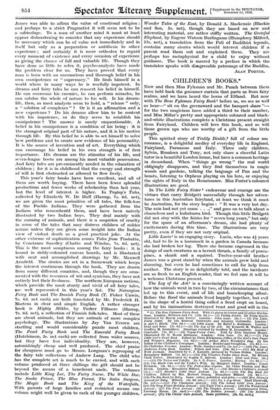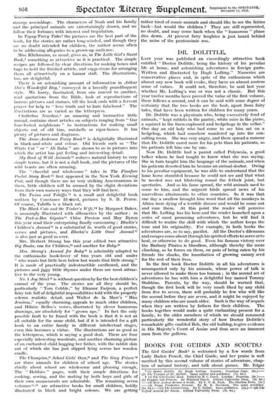CHILDREN'S BOOKS.*
Now and then Miss Fyleman and Mr. Punch between them have held back the gossamer curtain that parts us from fairy realms, and we have heard the horns of Elfland. But now with The Rose Fyleman Fairy Book'. before us, we see as well as hear-" sit on the greensward and the banquet share "- for the two magicians have added a third to their number, and Miss Millar's pretty and appropriate coloured and black- and-white illustrations complete a Christmas present straight from Fairyland. Children will love this book, and so will those grown ups who are worthy of a gift from the little people.
This spirited story of Tinkly Dinkle,3 full of colour ant romance, is a delightful medley of everyday life in England, Fairyland, Parnassus and Italy. Three only children, Sylvia, Rosaleen and Tony, not only share a cheerful Latin tutor in a beautiful London house, but have a common heritage in dreamland. When " things go wrong " the real world obligingly disappears, and they find themselves in magic woods and gardens, talking the language of Pan and the beasts, listening to Orpheus playing on his lute, or enjoying the sights of Italy in the Renaissance. Miss Foster's coloured illustrations are good.
In The Little Fairy Sister 3 endeavour and courage are the virtues that carry Bridgett successfully through her adven- tures in this Australian fairyland, at least we think it must be Australian, for the story begins : " It was a very hot day. The rain had not yet come . . .," and goes on to talk about a chameleon and a kukaburra bird. Though this little Bridgett did not stay with the fairies for " seven long years," but only for the space of an afternoon's dream, she had plenty of excitements during this time. The illustrations are very pretty, even if they are not very original.
Little Lucie is an engaging story. Lucia, who was 4i years old, had to lie in a hammock in a garden in Canada because she had broken her leg. There she became engrossed in the doings of such creatures as a hermit thrush, a family of porcu- pines, a skunk and a squirrel. Twelve-year-old brother James was a great stand-by when the animals grew bold and alarming, but even he had sometimes to call for help from mother. The story is so delightfully told, and the incidents are so fresh to an English reader, that we feel sure it will be a welcome Christmas present.
The Log of the Ark1 is a convincingly written account of how the animals went in two by two, of the circumstances that
led up to this event, and of life and housekeeping afloat. Before the flood the animals lived happily together, but evil in the shape of a horrid thing called a Scud crept on board, and by his insinuations destroyed trust and good will in the
• (1) The Rose Fgleman Fairy Book. With 12 plates in Colour and 12 other Illustra- tions. London; Methuen and Co, (10s. 6d.)---(2) Tinkly Hinkle. By Netts Syrctt Illustrated by Marcia Lane Foster. London : John Lane. [6s.1-(3) The Little, Fairy Sider. By Ida Renton! Outhwalte and Grenbry Outhwalte. London : A. and C. Black. [10s. 6d.]-(4) Little Lucia. By Mabel L. Robinson. London : Dent and Sons. [3a. 6d.]-(5) The Log of the Ark. By Kenneth M. Walker and Geoffrey. M. Bonmphrey. Drawings restored by Geoffrey M. Boumphrey. Louden Constable. [7s. 6d.]-(6) Topsy-Turvy Tales. Told by Elsie Smeaton Munro. Illustrated by D. Heath Robinson. London : John Lane. [7s. 6d.]-(7) The Little Gill's Stoed Book. Edited by Flora Klickmann (Office of the Ow,: Own Paper and Woman's Magazine. [is. 6c1.1-(8) Arthur Mee's Wonderful Day. By the Editor of the Children's Newspaper. London : Hodder and Stoughton. [7s. 6d.]---- (9) Chatterbox Newsbox. London : Wells, Gardnerand Co. [2s.net.J-(10) The Anne- Anderson Fairy Book. London : Nelson and Sons. [10s. 6d.]--(11) My Book of was Animals. Described by C. 5. %sherry, pictured by Vernon Stokes. London Humphrey Milford. Els. gd.}-(12) The Pinafore Pocket Story Book. By Miriam Clark Potter. Illustrated by Sophia T. Balcom. London: Dent and Sons. [Se.] -(13) The Twins and Tabiffa. By S. B. l'earse. London : Harrap. [Is. 6d.]- (14) The Black Cats and the Tinker's Wife. By Margaret Baker. London : Grant Richards. [2s. 6d.1-(15) The Peek-a-Boo Gipsies. By Chloe Preston and May Byron. London : Humphrey Milford. [3s. 6d1---(16) Blackie's Children's Annual (53.1--(17) Blackie's Little Ones' Annual. (3s. 6d.] (18) The Big Book for Children. Edited by Mrs. Herbert Strang. Humphrey Milford. [Es. (19) The Big Book for Baby. Same editor, publisher and prioe.----(20) Mrs. Strang's Annual for Baby. ?Milord. [38. ed. netj--(21) No. 1 Joy Street. Basil Blacks ell. (6s. net.]---(2.2) The Champion Annual ; (23) The School Girls' Own Annual ; (24) The Grey Friars Holiday Annual ; (25) Tiger Tim's Annual ; (26) The Wonderland Annual ; (27) The Puck Annual ; (28) The Playbox Annual. Amalgamated Pfess, Fleetway House. [6s. each.)- (29) The Bubbles Annual ; (30) 2 he Rainbow Annual; (31) The Chicks' Wm Arnaud, wade publisher. (34. Ga. eadi.1
strange assemblage. The characters of Noah and his family and the principal animals are entertainingly drawn, and we follow their fortunes with interest and trepidation.
In Topsy-Turvy Tales6 the pictures are the best part of the book, for the stories are rather long-winded, and though they arc no doubt intended for children, the author seems often to be addressing allegories to a grown-up audience.
Miss Klickmann, as usual, gives us, in The Little Girl's Sweet Book,7 something as. attractive as it is practical: The simple recipes are followed by clear directions for making boxes and !rags to hold the finished article, and suggestions for arranging them all attractively on a bazaar stall. The illustrations, too, are delightful.
There is an astonishing amount of information in Arthur Mee's Wonderful Day,' conveyed in a breezily grandiloquent style. We hurry, fascinated, from one marvel to another, read quotations from the Bible, look at reproductions of famous pictures and statues, till the book ends with a fervent prayer for help to " love truth and to hate falsehood." The illustrations are as varied as the letterpress.
Chatterbox Newsbox,' an amusing and instructive little annual, contains short articles on subjects ranging from " Our four-footed neighbours " to instructions for making small objects out of old tins, nutshells or cigar-boxes. It has plenty of picture's and diagrams.
The Anne-Anderson Fairy Book" is delightfully illustrated in black-and-white and colour. Old friends such as " The White Cat " or " Ali Baba " are shown to us in pictures into which the artist has put feeling and interesting detail.
My Book of Wild Animals" reduces natural history to very simple terms, but it is not a dull book, and the pictures of the wild beasts are often amusing.
The " cheerful and wholesome " tales in The Pinafore Pocket Story Book" first appeared in the New York Evening Post, and though there are no very striking Americanisms in them, little children will be amused by the slight deviations from their own nursery ways that they will find here.
The Twins and Tabiffa 13 is a small and delightful book written by Constance Howard, pictures by S. B. Pearse. Of course, Tabiffa is a black cat.
The Black Cats and the Tinker's Wife," by Margaret Baker, is amusingly illustrated" with silhouettes by the author ; in The Peek-a-Boo Gipsies" Chloe Preston and ,May Byron this year send•their enterprising family caravaning ; Blackie's Children's Annual" is a substantial 5s. worth of good stories, verses and pictures, and Blackie's Little Ones' Annual" is also just as good as ever.
Mrs. Herbert Strang has this year edited two attractive Big Books, one for Children," and another for Baby."
Mrs. Strang's Annual for Baby" is admirably adapted to the enthusiastic book-lover of two years old and under
who wants but little here below but wants that little strong." It is made of practically indestructible cardboard, and the pictures and jiggy little rhymes under them are most attrac- tive to the very young.
No. 1 Joy Stftet" is without question by far the best children's annual of the year. The stories are all they should be, particularly " Tom Cobble," by Eleanor Farjeon, a perfect fairy tale full of delightful impossibilities told with the properly solemn realistic detail, and Walter de la Mare's " Miss Jemima," equally charming, appeals to much older children, and Hilaire Belloc's verses, illustrated by clever humorous drawings, are absolutely for " grown ups." In fact the only possible fault to be found with the book is that it is not at all suitable for the same child, but if it is intended for a gift book to an entire family in different intellectual stages, even this becomes a virtue. The illustrations are as good as the letterpress, which is saying a good deal. There are four especially interesting woodcuts, and another charming picture of an enchanted child hugging her father, with the rabbit skin out of which she has just slipped lying across her wooden cradle.
The Champion," School Girls' Own,w and The Grey Friars" are three annuals for children of school age. The stories chiefly about school are wholesome and pleasing enough The " Hobbies " pages, with their simple directions for cooking, sewing, and the making by both boys and girls of their own amusements are admirable. The remaining seven volumes 11-31 are attractive books for small children, boldly illustrated in black and bright colours. We are getting
rather tired of comic animals and should like to see the fairies back—but would the children ? They are still represented, no doubt, and may come back when the " humorous " phase dies down. At present fairy laughter is just heard behind the noise of the pantomimic zoo.



















































 Previous page
Previous page